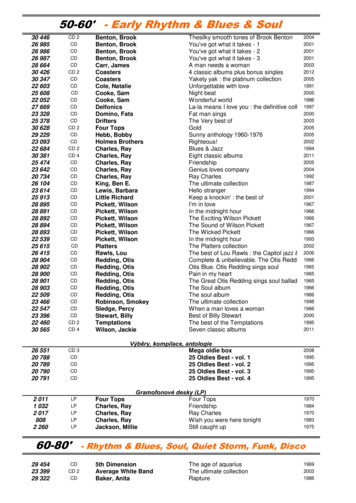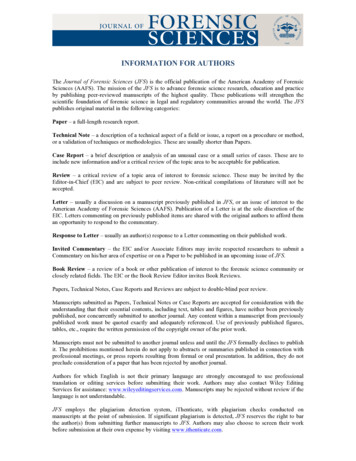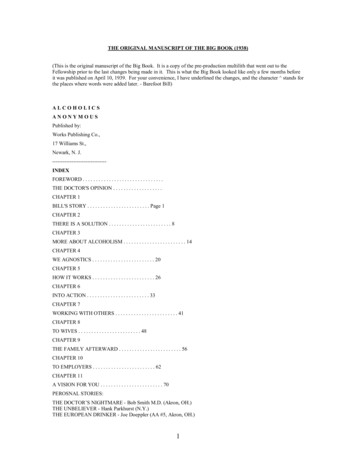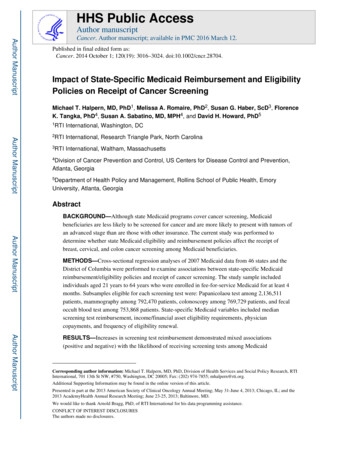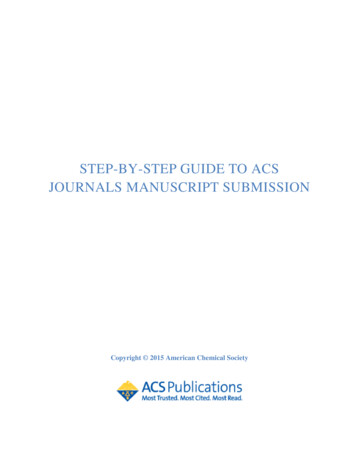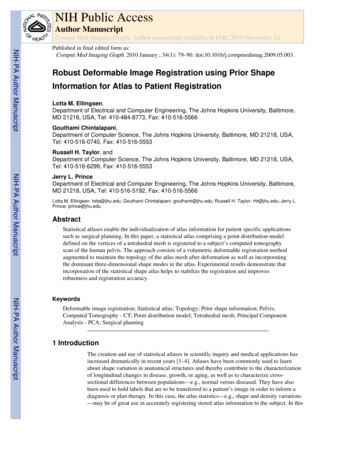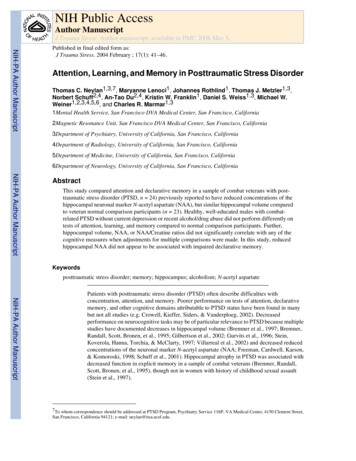
Transcription
NIH Public AccessAuthor ManuscriptJ Trauma Stress. Author manuscript; available in PMC 2008 May 5.NIH-PA Author ManuscriptPublished in final edited form as:J Trauma Stress. 2004 February ; 17(1): 41–46.Attention, Learning, and Memory in Posttraumatic Stress DisorderThomas C. Neylan1,3,7, Maryanne Lenoci1, Johannes Rothlind1, Thomas J. Metzler1,3,Norbert Schuff2,4, An-Tao Du2,4, Kristin W. Franklin1, Daniel S. Weiss1,3, Michael W.Weiner1,2,3,4,5,6, and Charles R. Marmar1,31Mental Health Service, San Francisco DVA Medical Center, San Francisco, California2Magnetic Resonance Unit, San Francisco DVA Medical Center, San Francisco, California3Department of Psychiatry, University of California, San Francisco, California4Department of Radiology, University of California, San Francisco, California5Department of Medicine, University of California, San Francisco, California6Department of Neurology, University of California, San Francisco, CaliforniaNIH-PA Author ManuscriptAbstractThis study compared attention and declarative memory in a sample of combat veterans with posttraumatic stress disorder (PTSD, n 24) previously reported to have reduced concentrations of thehippocampal neuronal marker N-acetyl aspartate (NAA), but similar hippocampal volume comparedto veteran normal comparison participants (n 23). Healthy, well-educated males with combatrelated PTSD without current depression or recent alcohol/drug abuse did not perform differently ontests of attention, learning, and memory compared to normal comparison participants. Further,hippocampal volume, NAA, or NAA/Creatine ratios did not significantly correlate with any of thecognitive measures when adjustments for multiple comparisons were made. In this study, reducedhippocampal NAA did not appear to be associated with impaired declarative memory.Keywordsposttraumatic stress disorder; memory; hippocampus; alcoholism; N-acetyl aspartateNIH-PA Author ManuscriptPatients with posttraumatic stress disorder (PTSD) often describe difficulties withconcentration, attention, and memory. Poorer performance on tests of attention, declarativememory, and other cognitive domains attributable to PTSD status have been found in manybut not all studies (e.g. Crowell, Kieffer, Siders, & Vanderploeg, 2002). Decreasedperformance on neurocognitive tasks may be of particular relevance to PTSD because multiplestudies have documented decreases in hippocampal volume (Bremner et al., 1997; Bremner,Randall, Scott, Bronen, et al., 1995; Gilbertson et al., 2002; Gurvits et al., 1996; Stein,Koverola, Hanna, Torchia, & McClarty, 1997; Villarreal et al., 2002) and decreased reducedconcentrations of the neuronal marker N-acetyl aspartate (NAA; Freeman, Cardwell, Karson,& Komoroski, 1998; Schuff et al., 2001). Hippocampal atrophy in PTSD was associated withdecreased function in explicit memory in a sample of combat veterans (Bremner, Randall,Scott, Bronen, et al., 1995), though not in women with history of childhood sexual assault(Stein et al., 1997).7To whom correspondence should be addressed at PTSD Program, Psychiatry Service 116P, VA Medical Center, 4150 Clement Street,San Francisco, California 94121; e-mail: neylan@itsa.ucsf.edu.
Neylan et al.Page 2NIH-PA Author ManuscriptWe reported that NAA is reduced in the hippocampus of PTSD patients in the absence ofhippocampal volume loss (Schuff et al., 2001). NAA occurs at high concentrations in neuronsand is virtually nondetectable in other tissues (Birken & Oldendorf, 1989). Hippocampal NAAlevels are presumed to reflect neuronal number or metabolism, in contrast to hippocampalvolume, which reflects all cell types including neurons and glia. Reduced hippocampal NAAin our study was consistent with findings implicating hippocampal damage in PTSD. Further,reduced NAA in the setting of normal hippocampal volume suggests that NAA may be a moresensitive measure of the integrity of the hippocampus.Comorbid alcohol and substance abuse affect performance on neurocognitive testing(Goldman, Brown, Christiansen, & Smith, 1991), are associated with lower hippocampalvolume (Laakso et al., 2000), and may therefore confound studies of these functional andstructural domains in PTSD. Our previous study utilized the most stringent criteria forexcluding comorbid conditions of any study examining hippocampal volume in PTSD.Specifically, we excluded participants with a history of alcohol or substance abuse/dependencefor the past 5 years and participants with history of major depression within the past 3 months.NIH-PA Author ManuscriptThis study compares attention, learning, and memory performance in the sample of Vietnamcombat veterans with and without posttraumatic stress disorder reported in the Schuff et al.(2001) study. Given our finding of reduced hippocampal NAA in PTSD, our originalhypothesis was that PTSD participants, even after controlling for comorbid alcoholism,substance abuse, and depression, would perform worse on tests of attention and declarativememory when contrasted with normal comparison participants. Further, given that NAA is asensitive measure of hippocampal neurons that are crucial for performance on tasks of memory,we hypothesized that performance on tests of declarative memory would be directly related tohippocampal NAA concentration.MethodParticipantsNIH-PA Author ManuscriptMedically healthy male Vietnam combat veterans (PTSD participants N 24, mean age 51.0years, SD 2.5 years; normal comparison participants N 23, mean age 52.4 years, SD 3.1 years) were recruited from the San Francisco Veterans Affairs Medical Center and fromthe community. After a complete description of the study to the participants, written consentwas obtained. The Structured Clinical Interview for DSM-IV Diagnosis (SCID; First, Spitzer,Williams, & Gibbon, 1996) was used to rule out both current psychiatric disorders other thanPTSD and a history of current major depression in the past 3 months or alcohol or substanceabuse during the previous 5 years. PTSD diagnosis and severity was assessed with the ClinicianAdministered PTSD Scale (CAPS; Blake et al., 1995). Normal comparison participants witha lifetime history of PTSD were excluded. All participants with history of head trauma,neurologic disorder, or systemic illness affecting brain function were excluded. All participantstaking benzodiazepines or antipsychotic medication in the past 6 weeks were also excluded.A total of 96 participants consented and were evaluated. Forty-nine were excluded because ofthe above inclusion and exclusion criteria.The mean education level was 15.1 years (SD 2.2 years) for the PTSD participants and 16.4years (SD 2.4 years) for normal comparison participants. Among the PTSD participants, 14had past history of major depression and 14 had past history of substance or alcohol abuse/dependence. Six of the PTSD participants were on antidepressant medications. Among thecomparison participants, 4 had past history of major depression and 9 had past history ofsubstance or alcohol abuse/dependence. None of the normal comparison subjects were onantidepressant medication. The mean CAPS score of the participants with PTSD was 64.7(SD 11.7) and the mean CAPS of the normal comparison group was 6.4 (SD 7.2). EighteenJ Trauma Stress. Author manuscript; available in PMC 2008 May 5.
Neylan et al.Page 3NIH-PA Author Manuscriptof our PTSD participants were Caucasian, 3 were African American, 2 were Hispanic, and 1was Native American. Eighteen of our normal comparison participants were Caucasian, 2 wereAfrican American, 2 were Asian American, and 1 was Hispanic. Eleven of our PTSDparticipants were married, 8 were separated or divorced, and 5 were single. Thirteen of ournormal comparison participants were married, 5 were separated or divorced, and 5 were single.The mean score on the Global Assessment of Functioning Scale (Endicott, Spitzer, Fleiss, &Cohen, 1976) was 57 (SD 4.5) for the PTSD participants and 78 (SD 6.5) for normalcomparison participants, t(2, 45) 12.8, p .001.MeasuresThe California Verbal Learning Test (CVLT; Delis, Freeland, Kramer, & Kaplan, 1988) wasused to assess a variety of verbal learning and recall functions including short-term and delayedrecall, recognition performance, and vulnerability to interference effects. The primarymeasures analyzed for this study included immediate recall over five trials, short delay (3 min)and long delay (20 min) recall, intrusions, and recognition discriminability.NIH-PA Author ManuscriptSubtests from the Wechsler Memory Scale-III (Wechsler, 1997) were used to measure auditoryand visual attention and working memory (Digit Span and Spatial Span), and visual memory(Faces I and II—Family Pictures I and II subtests). The Benton Visual Form Discrimination(Benton, 1992) was used to assess immediate visual memory and the capacity for complexvisual form discrimination. The BVFD is a widely used measure of learning and memoryinvolving designs displayed briefly and then identified from memory by the participant.Administration Form F assesses the capacity for complex visual form discrimination, and FormG assesses immediate visual memory. The numbers of correct choices using the standardcriteria outlined in the manual determined the performance score.Data from the subscales of measures listed above are presented according to the domain theyquantify: (1) Attention and working memory: WMS-III—Digit span and Spatial span; BVFD—Form F (matching); (2) Learning/immediate recall: CVLT—List A, Trial 1, Trial 5, totalrecall, List B; WMS-III—Faces I, Family pictures-I; BVFD-Form G (memory); and (3)Delayed recall and recognition: CVLT—short delay free recall, long delay free recall,intrusions, discriminability; WMS-III—Faces II, Family pictures II.NIH-PA Author ManuscriptMagnetic Resonance Imaging (MRI) and 1H Magnetic Resonance Spectroscopic Imaging(MRSI) acquisition and processing were described in detail elsewhere (Schuff et al., 2001). Inbrief, the participants were scanned on a 1.5-T VISIONTM Magnetic Resonance (MR) systemusing a double spin echo sequence (DSE) with Time Repetition (TR)/Time Echo (TE) 1/TE 2 2500/20/80-ms timing, 3-mm slice resolution, and a volumetric magnetization-preparedrapid gradient echo sequence with TR/TE/Time of Inversion (TI) 10/4/300-ms timing, 15 flip angle, 10 1.0 mm2 inplane resolution, and 1.4-mm thick coronal partitions for structuralMRI. A Point Resolved Spectroscopy (PRESS) 1H MRSI (Bottomley, 1987) sequence withTR/TE 1800/135-ms timing and 1.1-ml sized MRSI voxels was used to acquire watersuppressed 1H MR spectra simultaneously from both hippocampi.ProcedureNeuropsychological testing was administered the morning before neuroimaging or on adifferent day. A masters level psychology research associate (ML) obtained theneuropsychological measures under the supervision of a clinical neuropsychologist (JR). Thetests were administered in the same order for all subjects. Testing took approximately 2 hrincluding a mid-session 20-min break. Participants were instructed to abstain from usingalcoholic beverages and were breathalyzed before testing. Participants also had urinalysis forJ Trauma Stress. Author manuscript; available in PMC 2008 May 5.
Neylan et al.Page 4drug toxicology on the day of neuropsychological assessment. Data from participants withdetectable alcohol levels or positive toxicology screens were excluded from the analysis.NIH-PA Author ManuscriptStatistical AnalysisDescriptive data provide means, standard deviations, and effect sizes of the measures of explicitmemory and attention. Group differences in cognitive performance were tested using twotailed t tests. With our sample sizes we had 0.80 power to detect an effect size of 0.70. Therelationship between explicit memory and hippocampal NAA was examined with Pearsoncorrelation coefficients (two-tailed). We had 0.80 power to detect a correlation of r .40.ResultsPerformance on measures of attention, learning, and memory are presented in Table 1. Therewere no sig-nificant differences in performance between PTSD and comparison participantson any of the cognitive measures. Most effect sizes had an absolute value of less than 0.3. Theonly exceptions showed that PTSD participants had less recall on Trial 1 for the CVLT inPTSD (effect size 0.34) and better visual recall on Faces II (effect size 0.44).NIH-PA Author ManuscriptThere were no significant correlations between measures of cognitive performance and rightor left hippocampal NAA. To exclude the possibility that systematic errors in estimating NAAconcentration, such as correction for tissue atrophy or T1 and T2 relaxation, obscured acorrelation with the neurospychological data, we also determined NAA/Cr ratios, which reducedependencies of atrophy and relaxations. After adjusting for multiple comparisons there wereno significant correlations between the NAA/Cr ratios and the neurospychological measures.Before adjustment complex visual form discrimination (Benton F) was positively correlatedwith left hippocampal volume, r .34, p .05, and there was a trend for a positive associationof immediate visual recall (Benton G) with right hippocampal volume, r .30, p .065.However, these two correlations did not remain significant after adjusting for multiplecomparisons.DiscussionThe major results of the study show that in this sample of well-educated combat veterans withchronic PTSD and non-PTSD participants, carefully chosen to minimize the impact ofcomorbid depression, substance, and alcohol abuse, there were no significant group differencesin standard measures of attention or memory for word-lists, realistic scenes, abstract designs,or unfamiliar faces. In addition there was no correlation of attention or memory withhippocampal volume or NAA.NIH-PA Author ManuscriptOur sample differs from previously published studies of PTSD and cognition on four variables.First, mean years of education level in our sample (15.1 years for PTSD) was the highest ofany of the above cited studies in which the mean years of education ranged from 12.7 to 14.2.Second, the mean age of our participants (51–52 years) was older than the participants in thestudies referenced above; however, this is not likely to bias our negative finding. Third, ourparticipants, as previously reported did not differ from comparison participants with respectto hippocampal volume (Schuff et al., 2001). Finally, our sample met the most stringent entrycriteria, relative to the studies listed above, for excluding participants who had a majordepressive episode in the past 3 months, or a diagnosis of alcohol or substance abuse in thepast 5 years.One implication of these results is that prior reports of impaired attention and declarativememory in PTSD, utilizing neurocognitive measures similar to those used in this study, mayhave been confounded by comorbid diagnoses of substance abuse and/or depression. AnJ Trauma Stress. Author manuscript; available in PMC 2008 May 5.
Neylan et al.Page 5NIH-PA Author Manuscriptexamination of the positive studies demonstrating significant differences in attention, learning,and memory show a range of effect sizes for PTSD status on neurocognitive functioning from0.7 to 2.0 (Bremner et al., 1993; Bremner, Randall, Scott, Capelli, et al., 1995; Gil, Calev,Greenberg, Kugelmass, & Lerer, 1990; Gilbertson, Gurvits, Lasko, Orr, & Pitman, 2001;Jenkins, Langlais, Delis, & Cohen, 1998; Moradi, Doost, Taghavi, Yule, & Dalgleish, 1999;Roca & Freeman, 2001; Sachinvala et al., 2000; Uddo, Vasterling, Brailey, & Sutker, 1993;Vasterling et al., 2002; Vasterling, Brailey, Constans, & Sutker, 1998; Yehuda et al., 1995).Our study was not sufficiently powered to detect small effect sizes for cognitive performance;however, we did have adequate power to find effects similar in magnitude to most of thosereported in the literature. The exclusion criteria regarding alcohol abuse in the prior literaturewith both positive and negative findings ranges from having no exclusions (but often withmatching PTSD and comparison participants on alcohol abuse) to 1 year without alcohol abuseor dependence. Hence, recent alcohol abuse does not appear to explain the variability in effectsizes across these studies. Although the effects of alcohol abuse on the brain are in partreversible within the first 3 months of abstinence (Pfefferbaum et al., 1995), the study byGilbertson et al. (2001) that excluded participants with a history of alcohol abuse in the pastyear, demonstrated that the effects of alcohol on cognition are still measurable for at least ayear after abstinence.NIH-PA Author ManuscriptThe presence of current comorbid major depression is a problem in most studies of PTSD andneurocognitive functioning. The exclusion of participants with current major depression in thissample potentially could have biased the sample to having milder PTSD symptoms. However,the mean CAPS score of our PTSD participants (64.7) is above 60, which has been defined asthe threshold for severe PTSD symptomatology by Weathers, Keane, and Davidson (2001).Although some investigators have suggested that depression is inextricably linked to PTSD,this study as well as recent neurobiological data (Yehuda, Halligan, Grossman, Golier, &Wong, 2002), suggest that major depression must still be carefully considered as a possibleconfound.A careful review of the literature demonstrated that the three studies of cognition conductedto date with the largest sample sizes have yielded negative findings (Barrett, Green, Morris,Giles, & Croft, 1996; Crowell et al., 2002; Zalewski, Thompson, & Gottesman, 1994). Thestudy by Barrett is particularly noteworthy because they found that veterans with PTSD alone(N 236) did not show lower scores on measures of cognitive functioning compared to normalcomparison participants (N 1,835), whereas veterans with both PTSD and a concurrentdiagnosis of depression, another anxiety disorder, or substance abuse (N 128) performedsignificantly less well. These results suggest that a diagnosis of PTSD alone is not stronglyassociated with cognitive impairment as assessed by these methods.NIH-PA Author ManuscriptSimilar to a study of women victimized by childhood sexual abuse (Stein et al., 1997), wefound no relationship between hippocampal volume and measures of declarative memoryfunction. Stein and colleagues suggested that the relatively young age of their women withchildhood sexual abuse (mean age 32) may have accounted for the lack of relationshipbetween hippocampal volume and declarative memory. We found similar results in a samplethat is approximately 20 years older with normal hippocampal volume. It remains possible thatthe relationship between hippocampal measures and cognitive performance are not discernibleuntil advanced ages, or in subjects with dementia. For example, the study that showed thelargest reduction in hippocampal volume, 26% (Gurvits et al., 1996), did not show anassociation of hippocampal size with verbal declarative memory. Finally, it is possible thatmeasures of gross brain structure and neurochemistry (e.g., NAA) are too insensitive to relateto subtle differences in neurocognition that may exist in samples of participants who performwithin the normal range of cognitive function.J Trauma Stress. Author manuscript; available in PMC 2008 May 5.
Neylan et al.Page 6NIH-PA Author ManuscriptAlthough the association between hippocampal volume and performance on the Benton VisualForm Discrimination did not remain significant after correcting for multiple comparisons, thecorrelation is similar to a finding by Gurvits et al. (1996) for a different test format using BVFDstimuli. In their study of combat PTSD (N 7) and combat normal comparison participants(N 7) a relationship was observed between Benton 15-s delayed recall performance and totalhippocampal volume. Similarly, in our study, performance on the Benton visual formdiscrimination was correlated with hippocampal volume. These findings are consistent withpreclinical data that demonstrate an important role of the hippocampus in regulatingvisuospatial processing (for review see Sewards & Sewards, 2002).NIH-PA Author ManuscriptFinally, it is important to note that performance measures in both of our groups are within thenormal range. The similar scores on measures of attention in the two groups are noteworthy,because decreased attention may account for differences in performance on manyneuropsychological measures (Gilbertson et al., 2001). It is also possible that our measures(e.g., subtests of the WMS-III and CVLT) are not sufficiently challenging for higherfunctioning, ambulatory PTSD patients, and thus may fail to detect subtle memory deficits inthis subgroup. For example, Bremner and colleagues detected strong group differences inPTSD versus comparison participants in logical memory performance, which involves arelatively challenging test of paragraph recall (Bremner, Randall, Scott, Bronen, et al., 1995).Future studies might assess a broader range of cognitive functions, such as narrative recall,other measures of concentration and working memory, planning, and organizational skills thatmay be more sensitive to differences in neurocognitive performance in higher-functioningindividuals.Summary and ConclusionsIn a sample of PTSD participants who do not differ from normal comparison participants withrespect to hippocampal volume, we were unable to discern any differences in performance ontasks of attention, learning, and memory. Further, to our knowledge, this is the first studyexamining the relationship of hippocampal NAA with cognition in PTSD. Despite significantlyreduced hippocampal NAA in PTSD, as previously reported by our group (Schuff et al.,2001), we were unable to find neurocognitive correlates of reduced NAA. Future studies willbe needed to further examine neurocognitive correlates to brain volume and chemistry usingboth more sensitive neuropsychological measures as well as spectroscopy measures in otherregions of the brain besides the hippocampus that are involved in attention and declarativememory.AcknowledgementsNIH-PA Author ManuscriptA VA Merit award grant (M. W. Weiner and C. R. Marmar) and the Sierra Pacific (VISN 21) Mental Illness Research,Education, Clinical Center (MIRECC) supported this study.ReferencesBarrett DH, Green ML, Morris R, Giles WH, Croft JB. Cognitive functioning and posttraumatic stressdisorder. American Journal of Psychiatry 1996;153:1492–1494. [PubMed: 8890689]Benton, AB. Benton Visual Retention Test. 5. San Antonio, TX: Harcourt Brace Jovanovich; 1992.Birken DL, Oldendorf WH. N-acetyl-L-aspartic acid: A literature review of a compound prominent in1H-NMR spectroscopic studies of brain. Neuroscience and Biobehavioral Reviews 1989;13:23–31.[PubMed: 2671831]Blake DD, Weathers FW, Nagy LM, Kaloupek DG, Gusman FD, Charney DS, et al. The developmentof a Clinician-Administered PTSD Scale. Journal of Traumatic Stress 1995;8:75–90. [PubMed:7712061]J Trauma Stress. Author manuscript; available in PMC 2008 May 5.
Neylan et al.Page 7NIH-PA Author ManuscriptNIH-PA Author ManuscriptNIH-PA Author ManuscriptBottomley PA. Spatial localization in NMR spectroscopy in vivo. Annals of the New York Academy ofSciences 1987;508:333–348. [PubMed: 3326459]Bremner DJ, Randall P, Vermetten E, Staib L, Bronen RA, Mazure C, et al. Magnetic resonance imagingbased measurement of hippocampal volume in posttraumatic stress disorder related to childhoodphysical and sexual abuse—A preliminary report. Biological Psychiatry 1997;41:23–32. [PubMed:8988792]Bremner JD, Randall P, Scott TM, Bronen RA, Seibyl JP, Southwick SM, et al. MRI-based measurementof hippocampal volume in patients with combat-related posttraumatic stress disorder. AmericanJournal of Psychiatry 1995;152:973–981. [PubMed: 7793467]Bremner JD, Randall P, Scott TM, Capelli S, Delaney R, Mc-Carthy G, et al. Deficits in short-termmemory in adult survivors of childhood abuse. Psychiatry Research 1995;59:97–107. [PubMed:8771224]Bremner JD, Scott TM, Delaney RC, Southwick SM, Mason JW, Johnson DR, et al. Deficits in shortterm memory in posttraumatic stress disorder. American Journal of Psychiatry 1993;150:1015–1019.[PubMed: 8317569]Crowell T, Kieffer K, Siders C, Vanderploeg R. Neuropsychological findings in combat-relatedposttraumatic stress disorder. Clinical Neuropsychologist 2002;16:310–321. [PubMed: 12607144]Delis DC, Freeland J, Kramer JH, Kaplan E. Integrating clinical assessment with cognitive neuroscience:Construct validation of the California Verbal Learning Test. Journal of Consulting and ClinicalPsychology 1988;56:123–130. [PubMed: 3346437]Endicott J, Spitzer RL, Fleiss JL, Cohen J. The Global Assessment Scale: A procedure for measuringoverall severity of psychiatric disturbance. Archives of General Psychiatry 1976;33:766–771.[PubMed: 938196]First, MB.; Spitzer, RL.; Williams, JBW.; Gibbon, M. Structured Clinical Interview for DSM-IV (SCIDI; Patient Version ed.). New York: New York State Psychiatric Institute, Biometrics Research; 1996.Freeman TW, Cardwell D, Karson CN, Komoroski RA. In vivo proton magnetic resonance spectroscopyof the medial temporal lobes of subjects with combat-related posttraumatic stress disorder. MagneticResonance in Medicine 1998;40:66–71. [PubMed: 9660555]Gil T, Calev A, Greenberg D, Kugelmass S, Lerer B. Cognitive functioning in post-traumatic stressdisorder. Journal of Traumatic Stress 1990;3:29–45.Gilbertson MW, Gurvits TV, Lasko NB, Orr SP, Pitman RK. Multivariate assessment of explicit memoryfunction in combat veterans with posttraumatic stress disorder. Journal of Traumatic Stress2001;14:413–432. [PubMed: 11469166]Gilbertson MW, Shenton ME, Ciszewski A, Kasai K, Lasko NB, Orr SP, et al. Smaller hippocampalvolume predicts pathologic vulnerability to psychological trauma. Nature Neuroscience2002;5:1242–1247.Goldman MS, Brown SA, Christiansen BA, Smith GT. Alcoholism and memory: broadening the scopeof alcohol-expectancy research. Psychological Bulletin 1991;110:137–146. [PubMed: 1891515]Gurvits TV, Shenton ME, Hokama H, Ohta H, Orr SP, Lasko NB, et al. Magnetic resonance imagingstudy of hippocampal volume in chronic, combat-related post-traumatic stress disorder. BiologicalPsychiatry 1996;40:1091–1099. [PubMed: 8931911]Jenkins MA, Langlais PJ, Delis D, Cohen R. Learning and memory in rape victims with posttraumaticstress disorder. American Journal of Psychiatry 1998;155:278–279. [PubMed: 9464211]Laakso MP, Vaurio O, Savolainen L, Repo E, Soininen H, Aronen HJ, et al. A volumetric MRI study ofthe hippocampus in type 1 and 2 alcoholism. Behavioural Brain Research 2000;109:177–186.[PubMed: 10762687]Moradi AR, Doost HT, Taghavi MR, Yule W, Dalgleish T. Everyday memory deficits in children andadolescents with PTSD: Performance on the Rivermead Behavioural Memory Test. Journal of ChildPsychology and Psychiatry and Allied Disciplines 1999;40:357–361.Pfefferbaum A, Sullivan EV, Mathalon DH, Shear PK, Rosen-bloom MJ, Lim KO. Longitudinal changesin magnetic resonance imaging brain volumes in abstinent and relapsed alcoholics. Alcoholism:Clinical and Experimental Research 1995;19:1177–1191.Roca V, Freeman TW. Complaints of impaired memory in veterans with PTSD. American Journal ofPsychiatry 2001;158:1738–1739. [PubMed: 11579019]J Trauma Stress. Author manuscript; available in PMC 2008 May 5.
Neylan et al.Page 8NIH-PA Author ManuscriptNIH-PA Author ManuscriptSachinvala N, von Scotti H, McGuire M, Fairbanks L, Bakst K, Brown N. Memory, attention, function,and mood among patients with chronic posttraumatic stress disorder. Journal of Nervous and MentalDisease 2000;188:818–823. [PubMed: 11191582]Schuff N, Neylan TC, Lenoci MA, Du AT, Weiss DS, Marmar CR, et al. Decreased N-acetyl aspartatein the absence of atrophy in the hippocampus of posttraumatic stress disorder. Biological Psychiatry2001;50:952–959. [PubMed: 11750891]Sewards TV, Sewards MA. On the neural correlates of object recognition awareness: Relationship tocomputational activities and activities mediating perceptual awareness. Consciousness and Cognition2002;11:51–77. [PubMed: 11883988]Stein MB, Koverola C, Hanna C, Torchia MG, McClarty B. Hippocampal volume in women victimizedby childhood sexual abuse. Psychological Medicine 1997;27:951–959. [PubMed: 9234472]Uddo M, Vasterling JJ, Brailey K, Sutker PB. Memory and attention in combat-related post-traumaticstress disorder (PTSD). Journal of Psychopathology and Behavioral Assessment 1993;15:43–52.Vasterling JJ, Brailey K, Constans JI, Sutker PB. Attention and memory dysfunction in posttraumaticstress disorder. Neuropsychology 1998;12:125–133. [PubMed: 9460740]Vasterling JJ, Duke LM, Brailey K, Constans JI, Allain AN Jr, Sutker PB. Attention, learning, andmemory performances and intellectual resources in Vietnam veterans: PTSD and no disordercomparisons. Neuropsychology 2002;16:5–14. [PubMed: 11853357]Villarreal G, Hamilton DA, Petropoulos H, Driscoll I, Rowland LM, Griego JA, et al. Reducedhippocampal volume and total white matter volume in posttraumatic stress disorder. BiologicalPsychiatry 2002;52:119–125. [PubMed: 12114003]Weathers FW, Keane TM, Davidson JR. Clinician-Administered PTSD Scale: A review of the first tenyears of research. Depression and Anxiety 2001;13:132–156. [PubMed: 11387733]Wechsler, D. Wechsler Memory Scale-III (WMS-III). San Antonio, TX: The Psychological Corporation;1997.Yehuda R, Halligan SL, Grossman R, Golier JA, Wong C. The cortisol and glucocorticoid receptorresponse to low dose dexamethasone administration in aging combat veterans and holocaust survivorswith and without posttraumatic stress disorder. Biological Psychiatry 2002;52:393–403. [PubMed:12242055]Yehuda R, Keefe RS, Harvey PD, Levengood RA, Gerber DK, Geni J, et al. Learning and memory incombat veterans with posttraumatic stress disorder. American Journal of Psychiatry 1995;152:137–139. [PubM
San Francisco, California 94121; e-mail: neylan@itsa.ucsf.edu. NIH Public Access Author Manuscript J Trauma Stress. Author manuscript; available in PMC 2008 May 5. Published in final edited form as: J Trauma Stress. 2004 February ; 17(1): 41-46. NIH-PA Author Manuscript
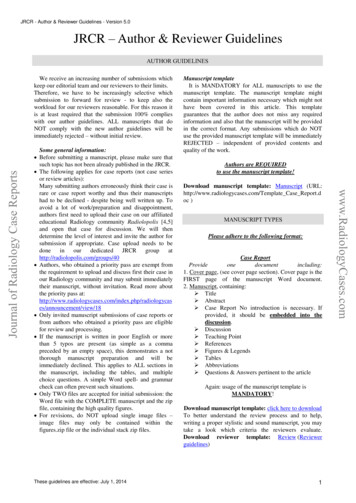
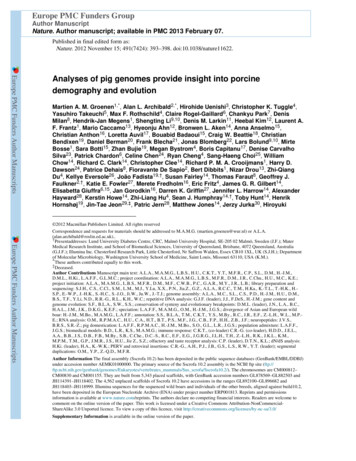
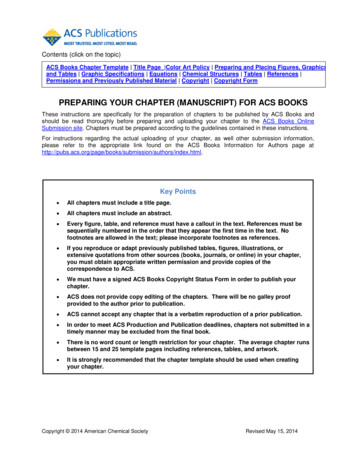
![The Book of the Damned, by Charles Fort, [1919], at sacred .](/img/24/book-of-the-damned.jpg)
